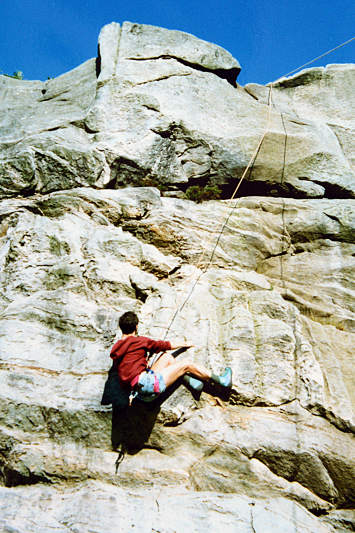My Roots - Climbing in Northumberland
I were born and bred up north. No that's a lie. I was born and bred in the home counties, in the soft south, but I lived for six years in Durham and that's where I started climbing so in that sense I can class my roots as indeed the north.
My earliest memories are of top-roping Diffs at Simonside, a bleak, broken outcrop high on the moors with my occasional walking partner and fellow scientist Rodney. But then in one of those freaks of nature a whole cluster of rock climbing astrophysicists appeared out of the cosmos. In the spring of nineteen ninety we spent happy evenings pushing our grades, admittedly with the security of a top rope, until I could struggle up a VS. But I kind of sensed then that this was not what I wanted.
I knew from my readings that climbing was about leading, although I could not begin to comprehend how much that really meant, but I knew I wanted to lead. Rodney had once told me that he knew someone that led Severes, I was gobsmacked, it felt unimaginable. Fortunately there was someone else among that bunch of cosmic collaborators who shared my dream. His name was Tim and we set about with a purpose to achieve this aim. First I had to build up my rack, from what sufficed for top roping to what might be required to lead. Harness, rope and EB rainbows were supplemented with nuts, runners, hexes, screwgates and slings. More esoteric gear like friends would have to wait as I sunk my money into the basics.

Then the time came when we had to face the rock, the talking had to stop and the leading begin. Sod all that VS stuff I had been managing it was back to those Diffs at Simonside, starting with a climb I had done before. Prior knowkedge I know you'll say, cannot count as an onsight ascent. Alright but we had to start somewhere and the bottom was good enough for me. Besides both Tim and I were in the same boat, there was no one with experience to show us the ropes, so to speak, we had to learn by experience and pool our knowledge. However I must have grown quickly in confidence because by the end of the day I had led a mild severe on sight.
In that brilliant, balmy summer of nineteen ninety I climbed more often than I have since. Midweek outings with the astro group when the evenings never got dark, then more at the weekends. Within a month I had led severe, within two we conquered our first multi-pitch climb, Troutdale Pinnacle, and I unknowingly led my first 5a on the notorious severe Shepherd's Chimney, and within three, by the end of that summer, we had both led VS. This meteoric rise was unsustainable and it would take me four more years to lead my first HVS although I came close in ninety two.
Over the next two years we explored the crags of Northumberland and North Yorkshire with only a couple more excursions to the Lake District. I mostly climbed with Tim but would sometimes pair up with others. Ray was a notable case, he was another of the astronomers, and he was a very good climber by our standards which was a good job because his gear was frighteningly old. He had the old style square cut nuts on ragged 5mm cord which was bleached with age. I cannot imagine that it would have held him had he fallen on some of it, but it did not really matter because his gear invariably lifted out as he climbed above it and slid down the rope to where I could unclip it and stash it. Ray was unphased by this and would happily continue.
The rocks of Northumberland are for the most part made of Fell Sandstone ( the main exceptions being the quartz dolerite crags below Hadrian's Wall ) and the best examples are in the north of the county near Holy Island. The names of the crags are kinder than the harsh names of the Peak outcrops such as Stanage and Froggatt, names like Back Bowden Doors and Kyloe in the Wood roll smoothly off the tongue with an epic quality. The crags are a similar size to the gritstone ones of the Peak and the rock has many similarities, after all gritstone is one type of sandstone, but it weathers more and forms runnels and pockets reminiscent of limestone. It is far superior to the Weald sandstone in Kent and in most places quite strong enough to take natural protection, although it can suffer from inconsiderate top roping or belaying.
At the beginning of nineteen ninety three I moved to London and those once familiar crags became a distant memory.
© Nick 1994